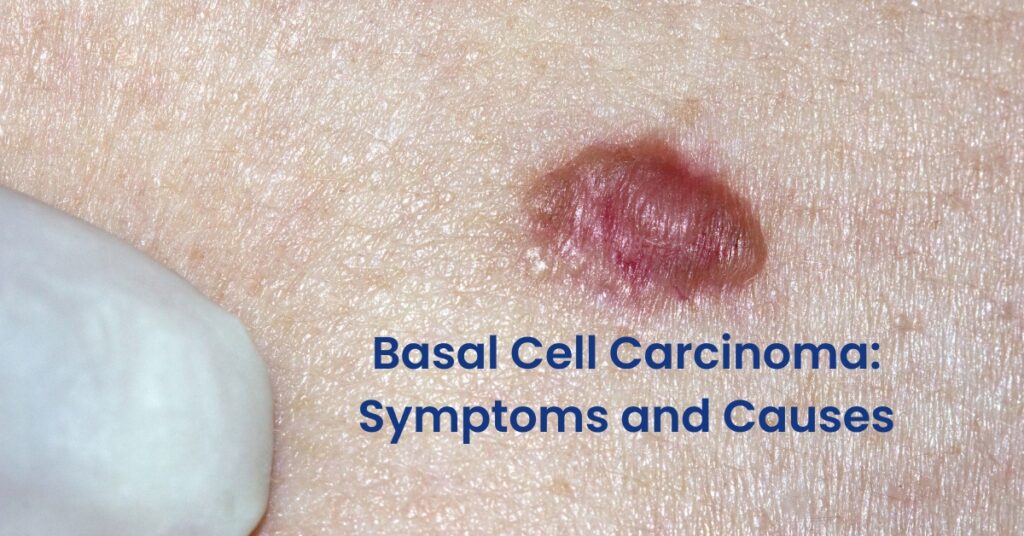Basal Cell Carcinoma: Symptoms and Causes

Skin cancer represents a significant health concern globally, with Basal Cell Carcinoma (BCC) ranking as the most common form of this disease. Emerging from the basal cells of the skin’s epidermis, BCC presents a complex array of symptoms, causes, and treatment options. This blog aims to delve into the depths of basal cell carcinoma, shedding light on its definition, symptoms, and causes.
What is basal cell carcinoma?
Basal cell carcinoma stands as a prevalent malignancy arising from the basal cells situated in the epidermis, which is the outermost layer of the skin. These basal cells play a crucial role in skin regeneration, but when subjected to genetic mutations, they can proliferate uncontrollably, giving rise to cancerous lesions.
Did you know? The five-year survival rate for localized basal cell carcinoma is nearly 100%. Act now to protect your skin. Schedule a screening today for peace of mind and optimal health.
What are the symptoms of basal cell carcinoma?
Basal cell carcinoma (BCC) is a type of skin cancer that originates in the basal cells, which are a type of cell within the skin that produces new skin cells as old ones die off. BCC is typically found in areas of the skin that have been exposed to the sun, such as the face, neck, and arms. However, it can also develop on parts of the body usually protected from the sun, such as the genitals. Here are some common symptoms of basal cell carcinoma:
- Pearly or Waxy Bump: A translucent, flesh-colored, or pearly white bump that may have visible blood vessels. On white skin, it may appear pink, while on brown and black skin, it often looks brown or glossy black. The bump can bleed and scab over and is often found on the face, ears, or neck.
- Flat, Scaly, Reddish Patch: A flat, scaly patch with a raised edge that may appear on the back or chest. This patch can be red or brown and often has a rough texture. Over time, these patches can grow quite large.
- Sore that Won’t Heal: A sore that bleeds, oozes, or crusts and remains open for weeks. It may heal and then come back.
- Scar-like Area: A white, yellow, or waxy area with poorly defined borders that resembles a scar. This can be an indication of a more invasive BCC.
- Itchiness or discomfort: Although not always present, some BCCs may cause itchiness or mild discomfort.
- Small, Pink Growth: A pink growth with a slightly raised, rolled edge and a crusted indentation in the center. As it grows, small blood vessels may develop on the surface.
- Shiny Nodule: A nodule that looks like a mole but is shiny and somewhat translucent, often found in sun-exposed areas.
- Brown, Black, or Blue Lesion: A lesion that may appear brown, black, or blue, or a lesion with dark spots and a slightly raised, translucent border.
Sometimes basal cell carcinomas can vary widely in appearance and may be mistaken for non-cancerous skin conditions such as eczema or psoriasis. Early detection and treatment are crucial to prevent BCC from becoming more serious. If you notice any persistent or unusual changes in your skin, it is important to consult a healthcare professional for an evaluation and possible biopsy.
What causes basal cell carcinoma?
Conclusion
Basal cell carcinoma (BCC) is primarily caused by long-term exposure to ultraviolet (UV) radiation from sunlight. However, there are several factors and conditions that can increase the risk of developing BCC. Here are the main causes and risk factors:
- UV Radiation Exposure
- Sunlight: Chronic sun exposure, especially in people who spend a lot of time outdoors without adequate sun protection.
- Tanning Beds: Use of indoor tanning beds, which emit UV radiation similar to the sun.
- Skin Type and Genetics
- Fair Skin: People with fair skin, light-colored eyes, and blond or red hair are more susceptible to UV damage and thus at higher risk.
- Genetic Predisposition: Certain genetic conditions, such as Basal Cell Nevus Syndrome (Gorlin Syndrome), increase the risk of developing BCC
- Age
Older Age: BCC is more common in older adults due to cumulative sun exposure over the years.
- Gender
Male Gender: Men are more likely than women to develop BCC, possibly due to higher rates of occupational sun exposure.
- Geographic Location
Living in Sunny Climates: People who live in regions with high levels of year-round sunlight, such as near the equator, have a higher risk.
- Previous Skin Cancer
History of BCC or Other Skin Cancers: Individuals who have had BCC or other types of skin cancer are at a higher risk of developing new BCCs.
- Radiation Therapy
Previous Radiation Therapy: Exposure to radiation for the treatment of other conditions can increase the risk of developing BCC in the treated areas.
- Immune System Suppression
Immunosuppressive Conditions and Treatments: People with weakened immune systems, such as those with HIV/AIDS or those taking immunosuppressive drugs after organ transplants, have a higher risk.
- Exposure to Toxic Substances
Arsenic Exposure: Chronic exposure to arsenic, found in some pesticides and contaminated water, can increase the risk of BCC.
- Chronic Inflammatory Skin Conditions
Chronic Skin Inflammation: Long-term skin inflammation or injuries can increase the risk of BCC.
In conclusion, understanding the symptoms and causes of basal cell carcinoma (BCC) is crucial for early detection, prevention, and effective treatment. Recognizing the various manifestations of BCC, from pearly or waxy bumps to flat, scaly patches, empowers individuals to seek medical attention promptly if any concerning changes appear on their skin. Moreover, comprehending the environmental and genetic factors that contribute to BCC underscores the importance of sun protection, lifestyle modifications, and regular skin examinations.
By staying informed and proactive, we can minimize our risk of developing BCC and promote overall skin health. Let’s unite in our efforts to raise awareness, prioritize sun safety, and foster a community dedicated to preventing and combating basal cell carcinoma.
References:
About Author
Dr. A. Venugopal
MD (General Medicine), DM (Medical Oncology), MRCP – SCE Medical Oncology (UK), ECMO (Switzerland).
Dr A. Venugopal is One of the best medical oncologist and Hemato Oncologist in hyderabad, currently serving as the Head of the Department and Senior Medical Oncologist, Hemato Oncologist at Pi Health Cancer Hospital in Gachibowli, Hyderabad. He brings over 15 years of extensive experience in the field of Oncology.

